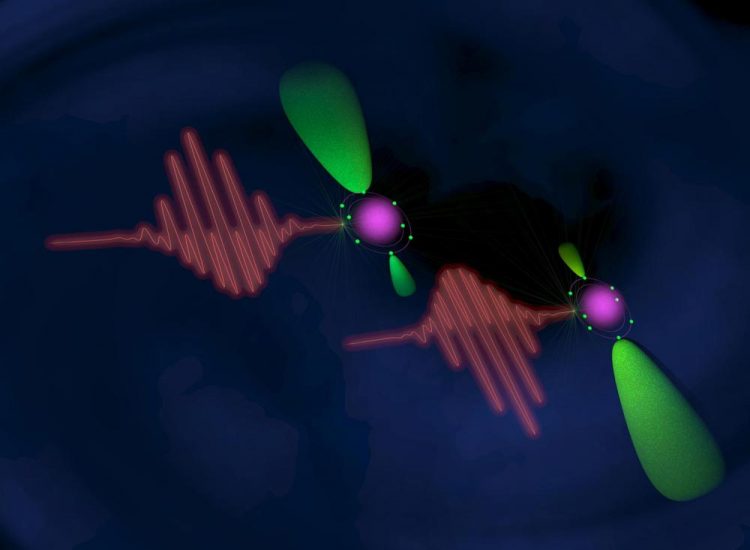Controlling ultrafast electrons in motion

Scheme of the experiment: pulses of light (waves) emit electrons (green) from a neon atom (violet). Image courtesy of Maurizio Contran, Department of Physics, Politecnico di Milano.
An international team has used the light produced by the Free Electron Laser FERMI at the research Centre Elettra Sincrotrone Trieste in the AREA Science Park to control the ultrafast movement of electrons. The experiment, published in the journal Nature Photonics, opens the way to the study of more complex processes which occur in nature on the scale of attoseconds (billionths of a billionth of a second), such as photosynthesis, combustion, catalysis and atmospheric chemistry.
Chemical, physical and biological processes are intrinsically dynamic, because they depend not only on the atomic and electronic structure of matter, but also on how they evolve in time. Ahmed Zewail won the Nobel prize (1999) for “femtochemistry”: the observation and control of dynamic chemical processes using ultrafast laser pulses, of a few millionths of a billionth of a second (femtoseconds). This is the scale of time on which atoms make or break bonds in chemical or biological processes, such as photosynthesis or combustion.
Nature however can be still “faster”. The atoms in a molecule move on the scale of femtoseconds, but the electrons, which are the basis of chemical bonds, are much faster and in the processes they cause, they move a thousand times faster, that is, tens or hundreds of attoseconds (a billionth of a billionth of a second).
“Like many in the scientific community”, explains Kevin Prince, first author of the article just published, “we have also been working for years to develop innovative analytical methods with attosecond resolution to study and control fast dynamics. With this work, that exploits the exceptional properties of the laser light from FERMI, we can say we have finally achieved our goal.”
The result was achieved by an international team of researchers from Italy (Elettra-Sincrotrone Trieste, the Politecnico of Milano, the IFN, IOM and ISM institutes of CNR and ENEA), Japan (Tohoku University), Russia (Lomonosov Moscow State University), USA (Drake University, Des Moines, Iowa) and Germany (Technical University of Berlin, University of Freiburg, European XFEL, Hamburg, Max Planck Institute for Nuclear Physics, Heidelberg).
They used a beam of light of two wavelengths (that is, two different colours) and managed to control the direction of emission of electrons ejected from an atom by the light. The experiment had a time resolution of 3 attoseconds, which now makes possible the study and control extremely fast processes.
“This result opens a new avenue to study and control ultrafast processes that involve electron motion on the time scale of attoseconds. We are dreaming about controlling more complex processes such as photocatalytic processes where the charge transfer plays a key role” said Kiyoshi Ueda, who with his group at Tohoku University, contributed to planning and conducting the experiment, and analysing the results.
###
This research have been published in the international journal Nature Photonics. To read more go to Ellettra's website: http://www.
See also: http://www.
Contact:
Dr. Kevin Prince
Elettra Sincrotrone Trieste, 34149 Trieste, Italy
Email: Prince@Elettra.eu
Tel: +39-040-3758584; +39-335 6949522
Prof. Kiyoshi Ueda and Dr. Denys Iablonskyi
IMRAM, Tohoku University, Sendai, Japan
Email:ueda@tagen.tohoku.ac.jp denys@tagen.tohoku.ac.jp
Tel: +81-(0)22-217-5481 (Ueda)
+81-(0)22-217-5483 (Iablonskyi)
Prof. Giuseppe Sansone
Politecnico di Milano, 20133 Milan, Italy
Email: giuseppe.sansone@polimi.it
Media Contact
All latest news from the category: Physics and Astronomy
This area deals with the fundamental laws and building blocks of nature and how they interact, the properties and the behavior of matter, and research into space and time and their structures.
innovations-report provides in-depth reports and articles on subjects such as astrophysics, laser technologies, nuclear, quantum, particle and solid-state physics, nanotechnologies, planetary research and findings (Mars, Venus) and developments related to the Hubble Telescope.
Newest articles

NASA: Mystery of life’s handedness deepens
The mystery of why life uses molecules with specific orientations has deepened with a NASA-funded discovery that RNA — a key molecule thought to have potentially held the instructions for…

What are the effects of historic lithium mining on water quality?
Study reveals low levels of common contaminants but high levels of other elements in waters associated with an abandoned lithium mine. Lithium ore and mining waste from a historic lithium…

Quantum-inspired design boosts efficiency of heat-to-electricity conversion
Rice engineers take unconventional route to improving thermophotovoltaic systems. Researchers at Rice University have found a new way to improve a key element of thermophotovoltaic (TPV) systems, which convert heat…



